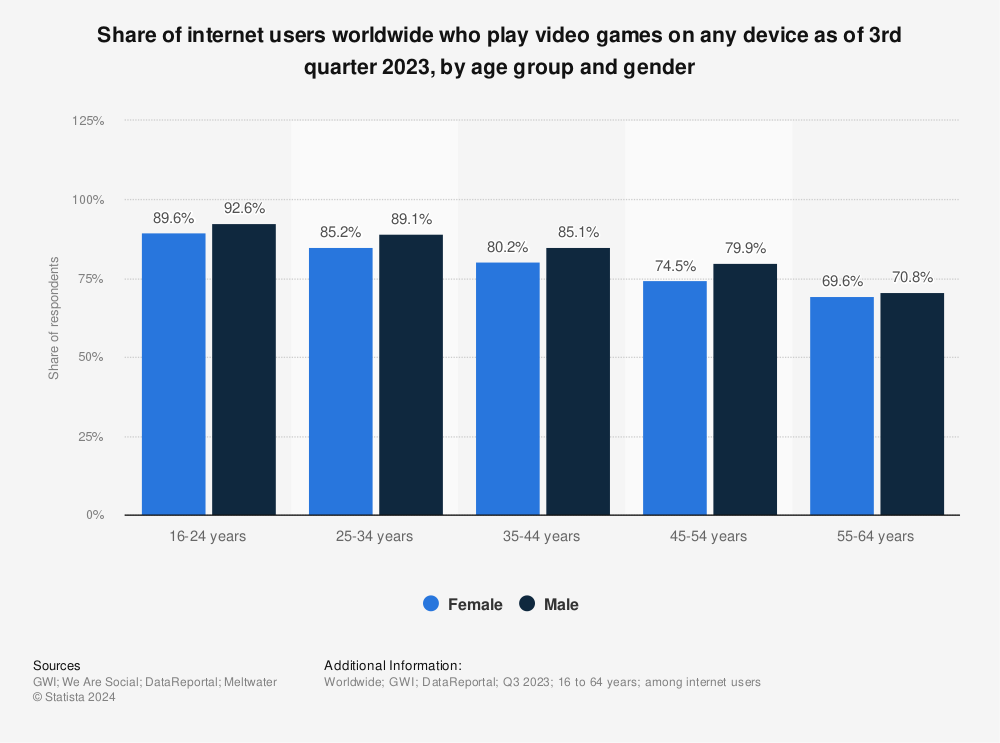Video games at school
School, Gaming ·58 mins read
This special post contains a list of video games useful for education, a guide for their implementation in class, tons of resources about this topic and my reflections on the benefits of gaming in school.
This post talks about video games, but don’t worry if you are not an expert! You don’t need prior knowledge or experience in them. Just knowing a general definition of video games and some examples is enough.
toc Table of contents
- toc Table of contents
- Education
- Feasibility: is it possible?
- The perfect educational video game
- Society & sociality
With the rising popularity of video games, playing them has become a normal activity for millions of us all over the world. They are popular with people of all ages, but especially with younger generations, including myself.
I’m not inventing that: today, according to ESA (Entertainment Software Association), nearly 227 million Americans (69% of the total USA population) play video games and three-quarters of kids under 18 play them weekly! I encourage you to read the source for more interesting stats. Furthermore, in 2018, the Pew Research Center reported in an article (Teens, Social Media and Technology 2018) that 83% of teen girls and 97% of teen boys played video games (whether on a computer, game console or smartphone).
Wanting to keep this post as truthful as possible, I must warn you not to take these statistics as absolute truths in the representation of society. Other articles, such as this one, and others can present variable results and there isn’t a universal conclusion. I talk about the gender difference later, if you are interested.
As I said in the previous post, video games have been one of my passions since I was younger, and with time I learned that they are not only a way to have fun or ward off boredom but also a precious tool that can be used in many useful ways.
Instead of lingering on the context, I’ll jump directly to the subject of this post and then do the rest.
Lately, I’ve come up with something aimed at taking advantage of the best benefits of gaming: bring video games into schools.
To explain why this rather curious idea holds up, I’ll split my arguments into two different parts: education and society.
Education
Most people strictly separate games from learning. When you say “educational video game” or “game-based learning”, some consider that an oxymoron, two things that cannot be together. In fact, gaming often gets this bad rap according to which it’s just a distraction tool, the “killer of education”, but lately the mentality seems to be more open. I believe that gaming should be taken seriously rather than superficially or with suspicion, and fortunately, others have begun to see it as a positive thing.
In formal education, digital games are frequently regarded as an unserious and unproductive pastime, and their potential for learning often stays undiscovered. But gaming is becoming a new form of interactive media that is worthwhile investigating.
Video games are non-linear systems, meaning outcomes depend on player choices unlike in linear representations such as those of books and films. This makes them a medium that involves interaction with a user to generate visual feedback on a computer or a video device to utilize fun, play, and competition.
Their beauty (and what makes them fun) is that they require active participation to be played. They contain a host of stimuli and interactions not present in a classroom that make them particularly suitable for new learning methods, especially “learn-by-doing”. You don’t just sit in front of a screen and wait for the game to be finished. This is the greatest advantage that education can use in its favor.
Normally, when a student listens to a theory lesson, he/she rarely participates with great endeavor or resolve and tends more often to passively listen to the teacher. This leads to distraction, indifference, and ultimately incomprehension, all consequences that strongly hinder the learning process. Also, the decision-making skills and the dialogic interaction among students are, if not completely, partially eliminated in this way.
Many techniques have been implemented at school to prevent this: homework, practical lessons/laboratory, group activities/projects, discussions with classmates, flipped classroom and many others. They mostly worked and are still working now, but they aren’t perfect and I think that something important is still missing. Something that really engages students to work with attention and commitment and, at the same time, doesn’t feel like a frustrating burden.
That’s exactly where video games are good at!
I want to underline, before going forward, that this post is not a call to slap gaming on top of education as a panacea. That wouldn’t work. However, incorporating video games in lessons not as substitutes for books or explanations but as learning enhancers can be literally game-changing for all students!
Loving what you learn is one of the most fundamental things that the school should convey to its students, but it’s often the last concern. Inserting game-based learning (not to be confused with gamification) in school lessons, instead, can better motivate them to study a subject, grasp its beauty and see it far more positively. When games are used to teach materials, students go beyond simple comprehension of content and learn new thought processes.
The exciting idea of playing video games would make students more focused, captivated and much more willing to learn, and this is what teachers can take advantage of to transmit them useful information about the subject taught.
“Game-based learning increases motivation and engagement, and if students are more motivated and engaged, they are more likely to stick with it and perform better” — André Thomas, CEO of Triseum
Therefore, being more attractive to the attention of students compared to traditional mechanisms, video games can increase learning motivation and eventually result in better learning effects.
But of course, you can’t just take a random video game and expect it to be educational. Unfortunately, only a small percentage of the video games currently on the market are suitable for that purpose and have some educational value. Usually, game developers aim for entertainment and don’t create much educational content.
However, there are some exceptions. In my experience with gaming, I discovered that educational games (sometimes also called serious games or epistemic games, with some nuances of meaning negligible here) exist, and they are not just the boring ones: even some of the most famous games in the gaming industry include educational features (see the examples below).
While discovering those hidden games and features, I started making a list of the best ones, and now I want to share it with all the reasons why they can be perfectly used for many subjects in schools.
Note: At the end of each video game description I’ve put a section “Helps with” where you can quickly see in what curricular topics that game can be used.
Assassin’s Creed Discovery Tours
Even if not designed to be educational, some games of the Assassin’s Creed series include a special separate mode called “Discovery Tour”: in Assassin’s Creed Odyssey, for example, players can explore Ancient Greece with its general culture, art, religion and everyday life. That’s why this game fits perfectly for a history lesson where students can learn about Greek history themselves through the exploration of a virtual world made specifically for that purpose.
 Demonstration of how this game could be used in the classroom. Source: Ubisoft official website.
Demonstration of how this game could be used in the classroom. Source: Ubisoft official website.
This is not the only Discovery Tour made by Ubisoft: at the moment of writing, there are other two Discovery Tours about Ancient Egypt and the Viking Age.
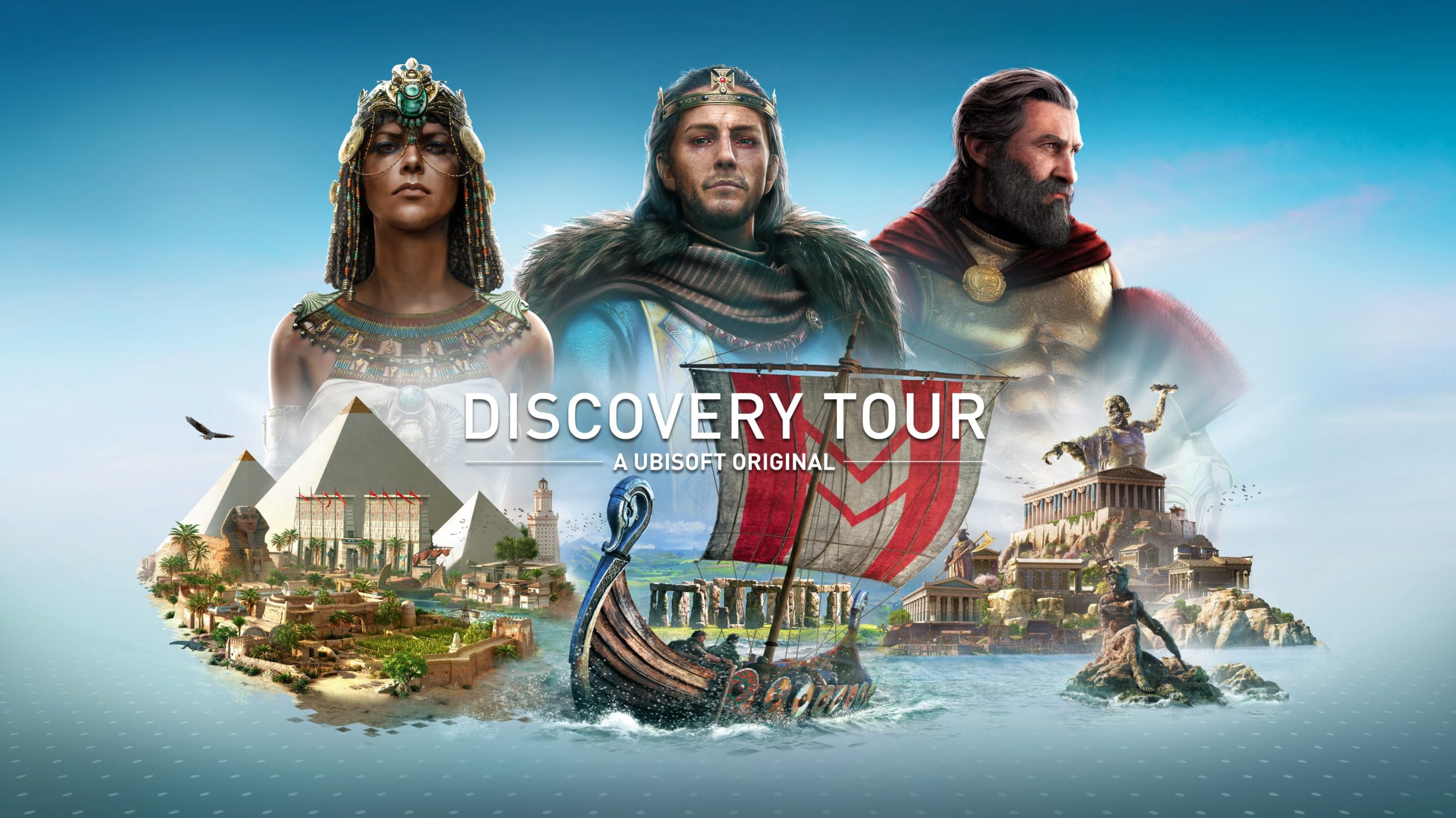 All three Assassin’s Creed Discovery Tours. Source: Ubisoft official website.
All three Assassin’s Creed Discovery Tours. Source: Ubisoft official website.
You can learn more on the official website where you can buy the games and watch all the trailers. Here’s one:
Helps with: History.
Minecraft Education Edition
Minecraft Education Edition is a special version of the original Minecraft game that includes special tools and virtual worlds that can be used by the teacher to create fun and formative learning environments.
It includes new collaboration tools and classroom controls like chalkboards, cameras, a world map view, the Code Builder and more to give teachers the possibility to create fun learning environments and students to generate a portfolio of their work to show the learning process.
With this game, while the students play with Minecraft following the instructions given (teachers have pre-made lessons, STEM curriculums and project-based challenges at their disposal), they also work together in an immersive 3D world where they have the opportunity to strengthen creativity, spatial visualization ability, problem-solving skills, leadership traits, teamwork, collaboration and social interactions.
This is the official website, that offers a robust library of pre-made lesson plans and world maps, STEM curriculums and project-based challenges that are always at the educator’s disposal. At the following link, instead, you can find a useful guide from Commonsense Education on how to use Minecraft (Vanilla version) in class in the best way. Get started with Minecraft Education Edition here and see the purchasing options.
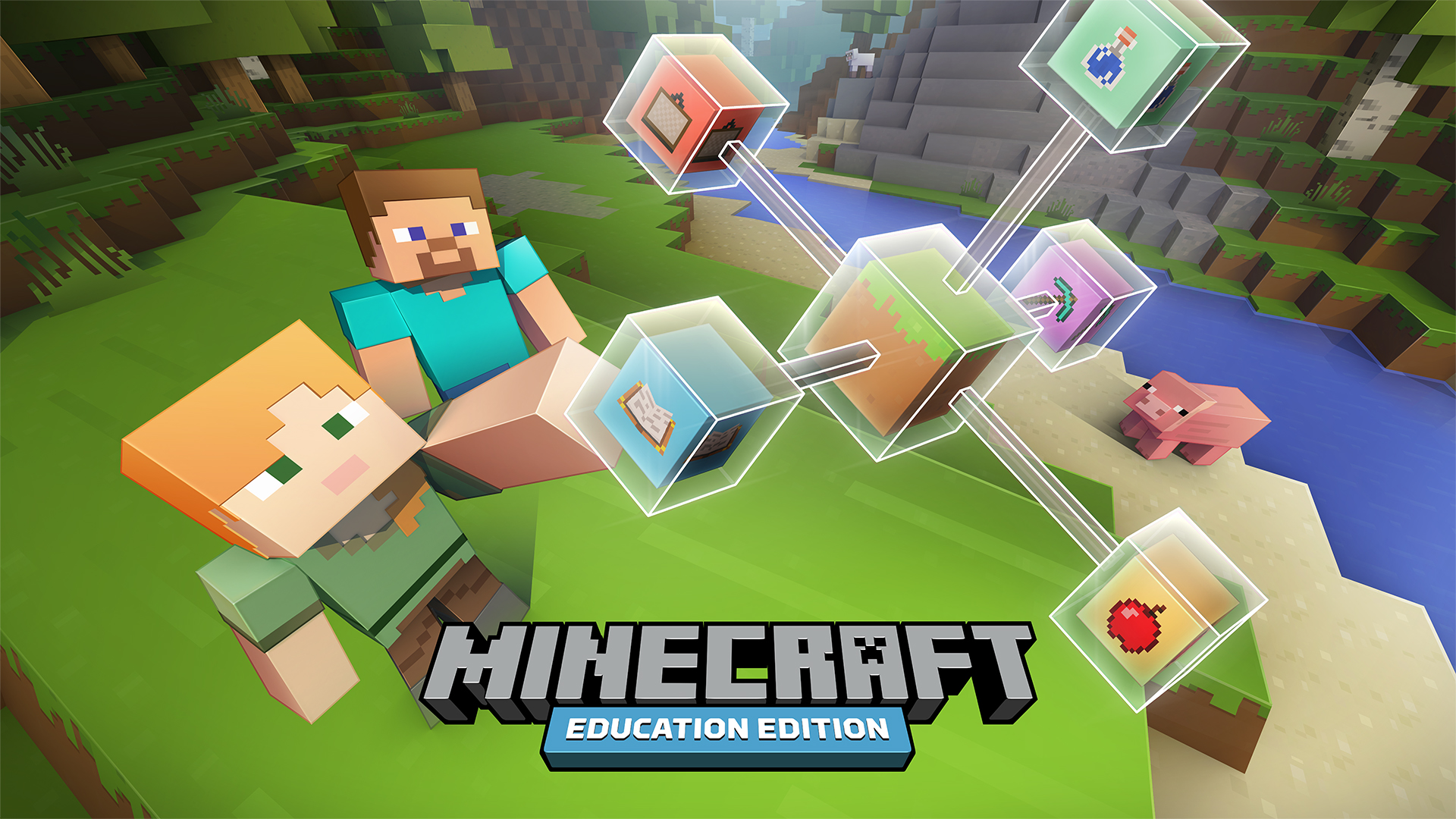
This game works better for younger people, but students of my age (16-17) and older can benefit from Minecraft and the expressive freedom that it gives to the player.
To provide a real example, in this period my electronics and telecommunications engineering teacher is teaching me and my classmates the logic gates. Incidentally, you can make working logic gates in Minecraft too (and not only that, but even entire computers!), just by using an in-game analog to electricity called “redstone” and other special blocks. The Education Edition is not even needed to make redstone circuits. A clever move could be to take advantage of that and show us, during a lesson, how each gate works using Minecraft instead of chalk and blackboard. Aside from digital benefits like immediate feedback and unlimited, encouraged experimentation thanks to the interactivity that comes with video games, I’m confident to say that the level of attention would skyrocket and, consequently, chances are that the same would happen with the understanding of that topic.
 Logic gates in Minecraft. Source: Reddit
Logic gates in Minecraft. Source: Reddit
Aside from STEM subjects, even artistic creations can be made in Minecraft. I had the opportunity to make one firsthand just a few months ago, in my third year of upper secondary school (the equivalent of high school) in Italy, when our teacher asked us to use our creativity to create a project focused on Dante Alighieri, a very famous Italian poet of the fourteenth century. My group and I decided to make a short film in (modded) Minecraft about the first three cantos of The Divine Comedy (🇮🇹 language).
This is not just a little example of what you can do with Minecraft, but also a practical demonstration that video games can be integrated in education, it’s not just a theory.
Helps with: STEM disciplines, Language arts, History & Culture, Art & Design, Digital Citizenship, Social Emotional, Equity & Inclusion, Climate & Sustainability.
Microsoft Flight Simulator (2020)
This game is a whole 3D simulation of the Earth that can be used in geography lessons to show from a top perspective what is below from cities to rivers, from oceans to forests all over the world.
These are some places in Europe, for example:
Being an airplane simulator, it can also be used in particular school courses to teach how to fly these vehicles without actually doing it.
See the official website for more info.
Helps with: Geography.
Beyond Blue
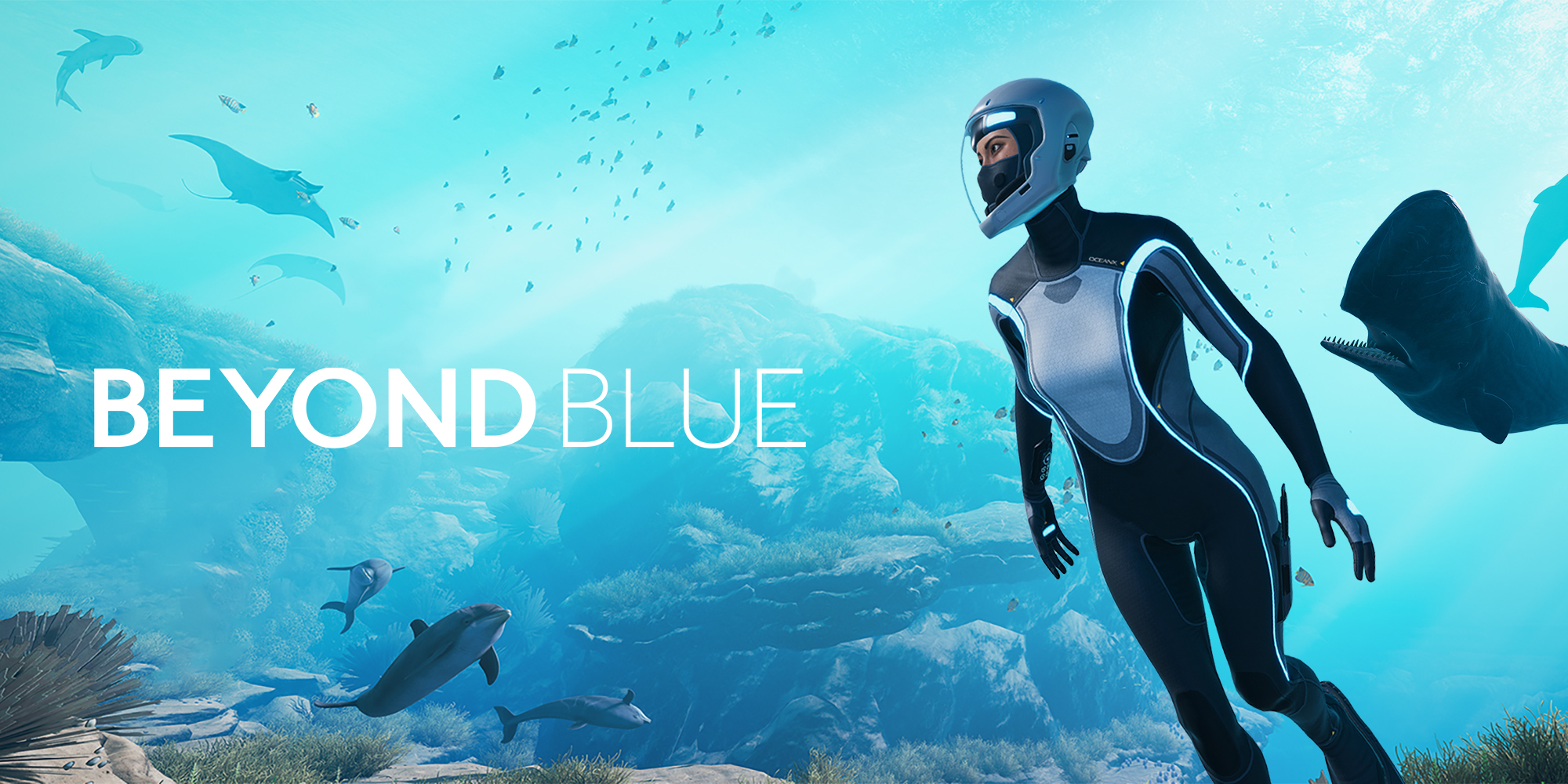
Beyond Blue is a single-player narrative adventure that takes players into the near future, where they have the opportunity to explore the mysteries of our ocean through the eyes of Mirai, a deep-sea explorer and scientist. She and her newly-formed research team use innovative technologies to see, hear, and interact with the ocean and its wildlife. The game features an evocative narrative and exploration of an untouched world.
To make this game, the developers of E-Line Media “partnered with BBC Studios (developers of the acclaimed nature documentary Blue Planet II), OceanX Media, world-class game makers, and some of science’s leading ocean experts to craft an experience that reflects the awesome wonder and unbounded mystery that infuses our planet’s beating blue heart.” — Beyond Blue official website.
As you are gathering information during gameplay, you’ll learn about fast-changing, human-made threats to the sea like climate change, plastic waste and overfishing, and many insights about sea creatures.
Zack Hartzman from Hey Listen Games prepared a lesson entirely based on this game and also wrote a post on Why You Should Teach With Beyond Blue if you are curious. I also recommend you to read this interesting article on this video game by Engadget: ‘Beyond Blue’ is an educational game about saving the ocean.
Helps with: Biology, Oceanography.
Kerbal Space Program
Kerbal Space Program is a famous rocket simulator. From this perspective, it seems not to be applicable to ordinary lessons, but the physics modeled in this game is so useful that both NASA and the European Space Agency officially endorse it1, and some schools even use this game to help teach math and physics and even rocket science.
 Orbital Mechanics - xkcd. Source: xkcd.com/1356/
Orbital Mechanics - xkcd. Source: xkcd.com/1356/
The developers at Teachergaming LLC also launched KerbalEdu, an educationally-enhanced standalone version of this space agency game (developed by Squad) which integrates features that are exclusive to the classroom. Read this article by PC Gamer for more info. Unfortunately, the project is now dead and I cannot ensure that KerbalEdu can still be downloaded and used.
Dan Fullerton, a physics teacher at Irondequoit High School in Rochester, New York, has tried to use this game and others at school to create interest in his students, and these are his words:
“My goal with the Kerbal Space Program is to build student interest in STEM fields and, following an entire year of technically challenging work, give them an opportunity to see how they can apply some of what they learned in a fun and engaging manner. I think any time you can capture the enthusiasm of a student, you have an opportunity. The trick as an educator is realizing our kids have varied interests, so we need to find ways to tie in what we do to each of their interests.2” — Dan Fullerton
Dan is not the only teacher to see the capabilities of KSP, and other educators have used it with their students to make experiments and actual demonstrations during the lessons., like Christopher Scott Vaughen, who created in 2020 a math and physics course entirely based on this game.
A sequel of the game has recently been released on several platforms, but it is still in the early access stage and lacks many features of the original. Also, its graphics requirements are significantly higher than the 2015 game. Still, there’s a lot of potential and it might be just a matter of time before being able to use the improved and boosted Kerbal Space Program 2 to teach physics with a more modern tool.
I’ll leave the link to the official website, the news about Christopher’s course and an educational review of this game by Common Sense Education.
Helps with: STEM disciplines.
Portal and Portal 2

Portal is another series of games not designed with education in mind, but the creators (Valve) promoted the use of their games for education. This initiative led to the use of Portal 2 in educational school courses, especially for learning STEM disciplines3. The foundry10.org organization developed an adaptation of Portal 2 that can be applied in classrooms in a program called Teach with Portals. This project is (well… was 😢) freely available with plenty of video-game-based lessons about gravity, conservation of energy, projectile motion, free fall, geometry, statistics and not only.
This blog post by Classroom Aid explains in detail how teachers used this game and what they taught. Here’s the introduction:
“Since its launch in June 2012, Valve’s free initiative Teach With Portals has brought Puzzle Maker to over 2,500 teachers nationwide, it aims to help teachers use the game Portal 2 to engage students in learning STEM. […] By converting its level-building software, Hammer Editor, into a much easier to use interface called Puzzle Maker, Valve has made it possible for anyone to design challenging Portal rooms”.
I provide a link to these resources, too:
- SingularityHub - Learn Science While Playing Video Games? Video Game Maker Valve Makes Dreams Comes True
- Physics with Portals (Cameron Pittman) - Why teach with Portals?
- Physics with Portals (Cameron Pittman) - Demonstration videos
Sadly, the Steam for School initiative launched in 2012 is now discontinued. I decided to put this game anyway on the list because it is still a great example of how video games can be integrated within the classroom.
Helps with: STEM disciplines.
Triseum Games
Triseum is a company that has developed many educational games. The best one is probably Variant: Limits, a calculus game published in 2017 where “students can visually see how manipulating equations impacts graphs, charts and their course of action, and therefore they are encouraged to use a trial and error approach4”.
In this game, you wake up isolated on a planet where you are researching with a team about an ancient, technologically advanced culture. You have to develop your understanding of limits to activate gates and bridges throughout the city as you investigate to learn what happened.
Variant: Limits connects mathematics and gameplay, empowering students to take a more active role in the learning process and engage with content on a deeper level. Focusing on finite limits, continuity and infinite limits, students explore, develop new knowledge and practice college-level calculus concepts in the game environment. They don’t just memorize and regurgitate information, but rather apply it. As students achieve learning objectives and advance to higher levels within the game, they are motivated to keep going5.
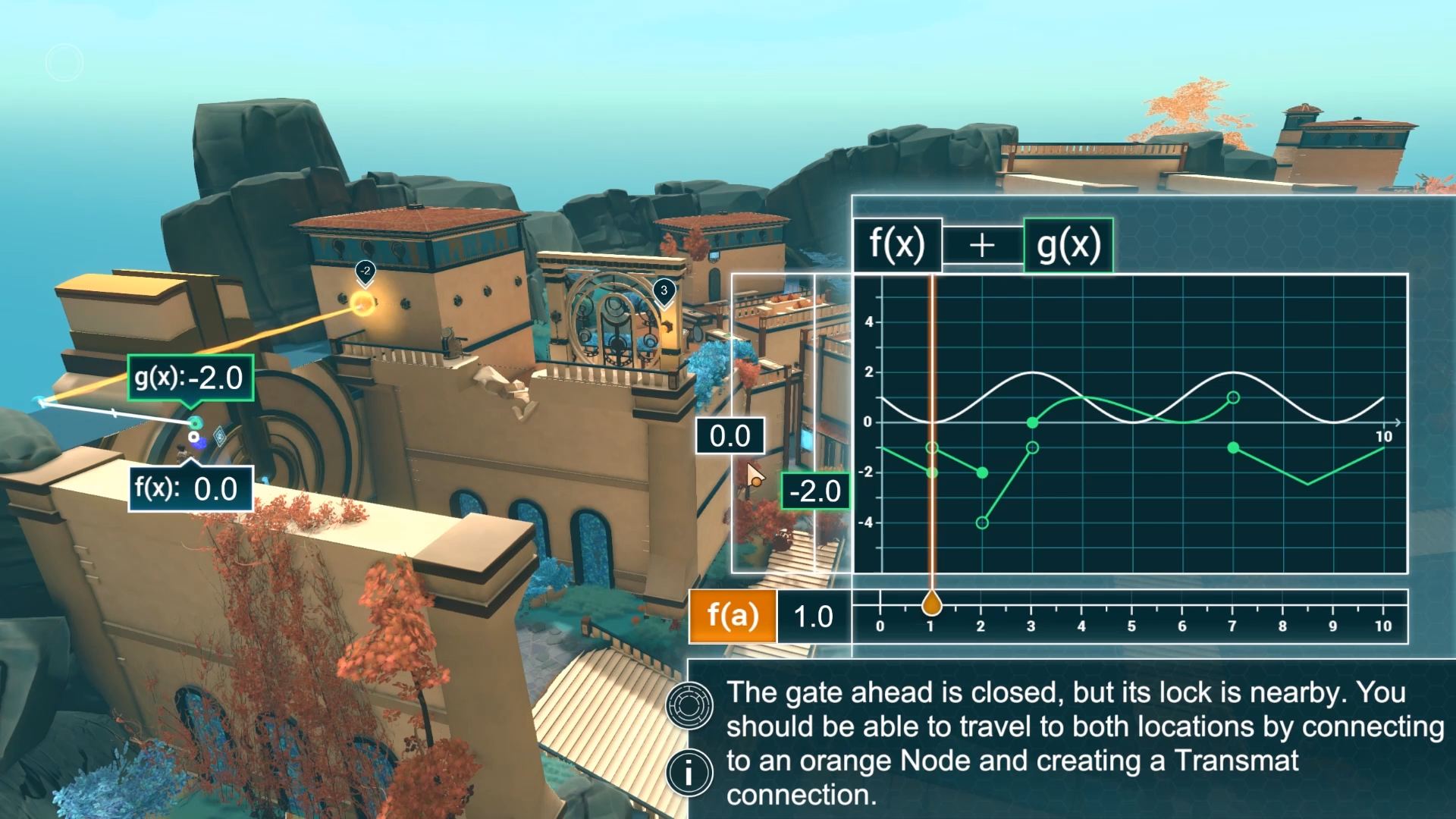 An example image of the gameplay.
An example image of the gameplay.
Watch this video to see some gameplay and how it works and read this review by Common Sense Education to see what it’s helpful with. An interesting thing is that students’ progress is reported to the teachers, so they can monitor the learning state.
I have to say, though, that this game feels a bit incomplete and in an early stage of development, even if it’s already published, and it’s not particularly well made from some perspectives. However, I greatly appreciate that Triseum with its games provides everyone with the demonstration that video games can be included at school with many benefits and they help to keep the students invested. Official website.
Helps with: Math.
Valiant Hearts: The Great War
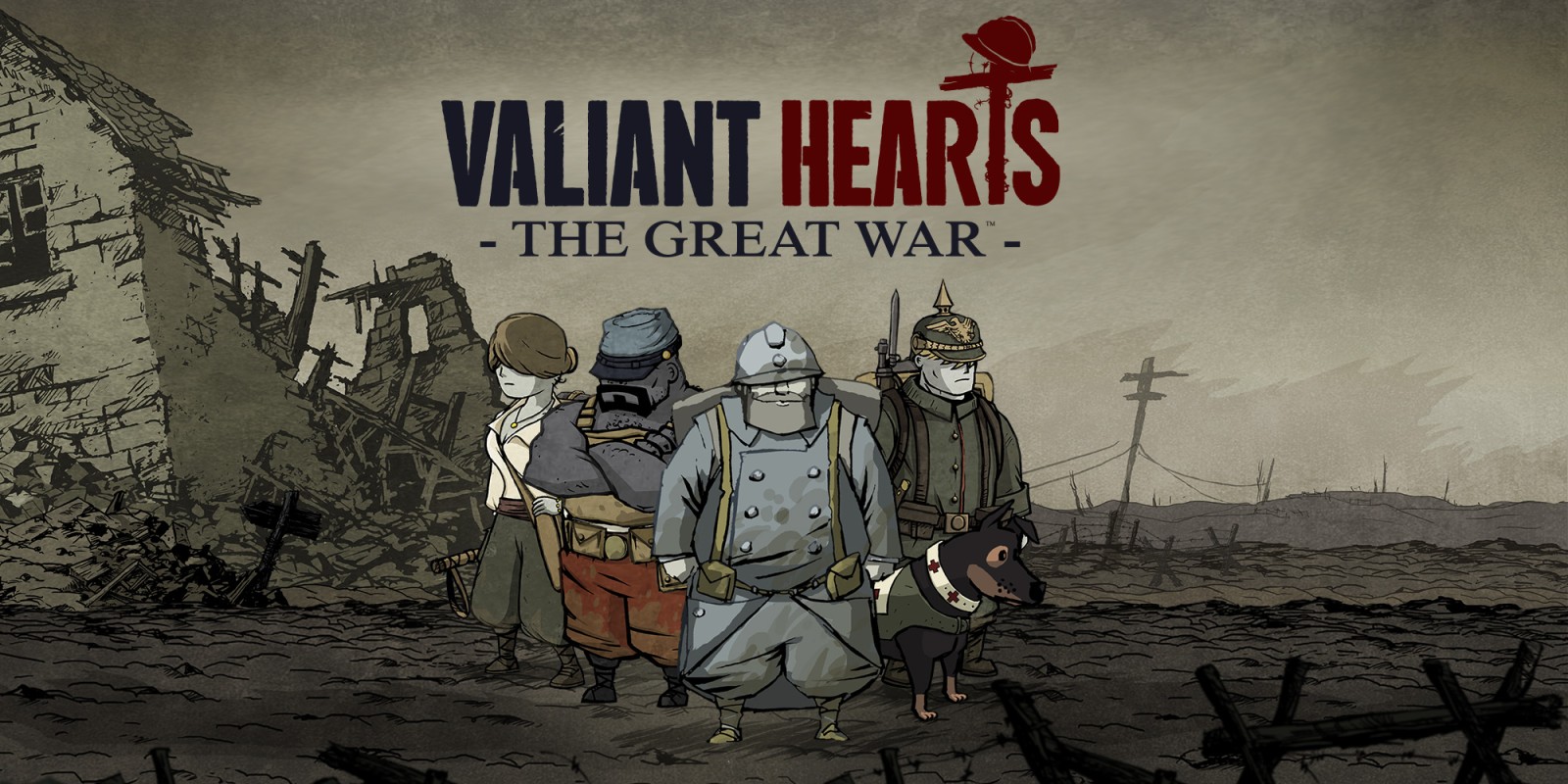
This game is a comic book brought to life that portrays the horrors of The Great War while remaining accessible to kids. You play as four strangers, accompanied by one dog, whose lives intertwine as they make their way through the trenches of war. The story may be fiction, but the locations and events are all based on fact.
Unlike many games set in the war, this is a game about war. Instead of combat, it is about exploration, adventure, and puzzles. As you play, you will come across artifacts, facts, and diary entries that all add to a greater portrait of World War I. These were included with the help of Mission Centenaire, a commemorative organization of the war, and Apocalypse World War I, a documentary mini-series about the war.
The game is made by Ubisoft Montpellier and is recommended for use in secondary education during history lessons.
Reviews about the educational value of this game ⬇️:
- Hey Listen Games - I Taught With Valiant Hearts: The Great War and lessons
- Common Sense Education - Valiant Hearts: The Great War educational review
- EuroClio - Video Game Review: Valiant Hearts, The Great War
- Fighter-Bomber’s Blog - Valiant Hearts: An Interactive First World War Education Tool
Helps with: History.
Earth Primer

This is more of an interactive textbook than a game, but it’s still fun to experiment with. It’s about Earth in all of its geological aspects. You can explore the 5 chapters (Earth’s Interior, Surface, Water Cycle, Biomes, and Sandbox) each organized into content areas or mini-lessons, that focus on a particular concept. You are encouraged to interact with the graphics to learn about our planet, exploring features such as volcanoes, dunes, mountains, weather and much more.
The game was created by the solo developer Chaim Gingold and published on iOS in 2015. Since then, the game has remained exclusive to Apple platforms and hasn’t made it to Windows and Android, although Chaim said on the official website that he plans to do a Windows version as well. I also recently contacted him for more information about the ports and he kindly replied to me saying that he is “still hoping to get it out the door one day” and hopes “that at some point it will rise in the heap of priorities again”. I think it’s important for this game to be supported on Windows simply because on desktop and laptop computers, Windows is the most used OS at 75% market share (Wikipedia). The more schools and students can access it, the better!
Reviews: Common sense education review and Common sense media review
Helps with: Science, Geology, Weather.
Cypher

If you are searching for a game about cryptography, Cypher by Mattew Brown is probably the best out there. The game takes place in a whitewashed museum with many rooms, each provided with tons of different puzzles to decipher. At the entrance of each room there are lovely descriptions about the history of cryptography, from simple substitution ciphers to the Enigma machine and beyond. The player grabs a pen and paper to test their deciphering skills across 40+ challenging puzzles.
The game, released in 2018, is available on PC and can be purchased on Steam at a moderate price.
Helps with: Cryptography.
Little Mouse’s Encyclopedia
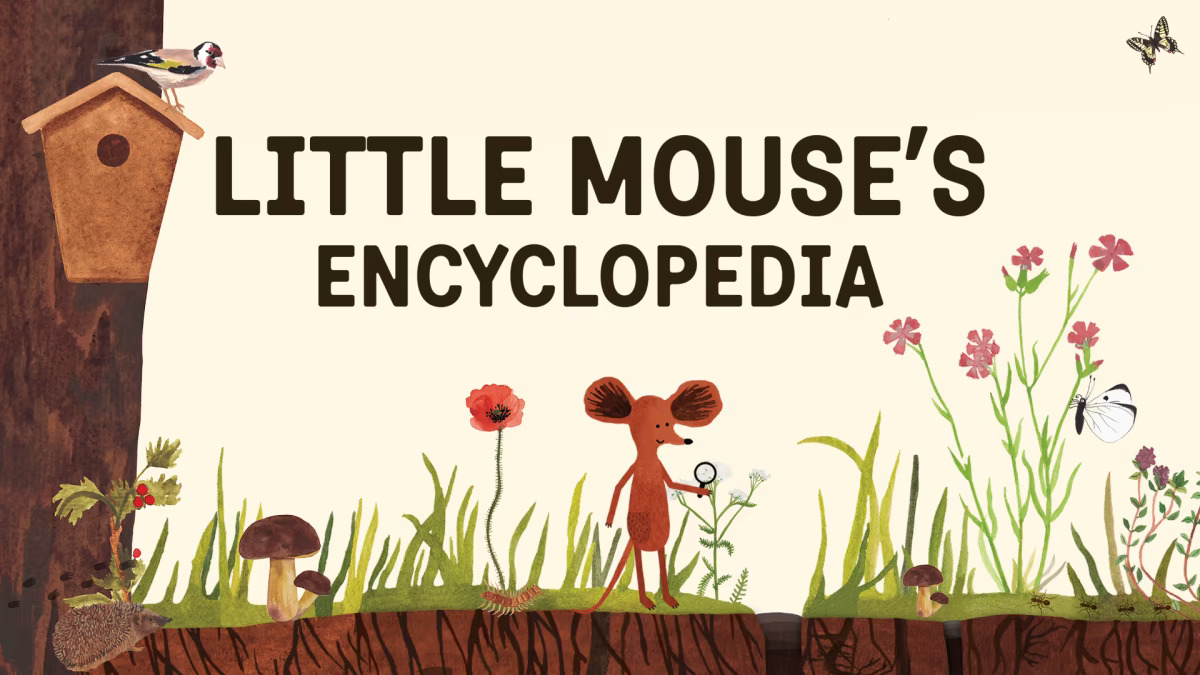
This charmingly illustrated game by Circus Atos sends you, an animated mouse, to a journey of discovery through nature, its laws and the primary species of flora and fauna in 4 different illustrated environments.
 Each animal or plant has an information card (called a “table” in the tutorial) that you can open to learn more. It might label the parts of a plant, indicate if a flower is poisonous or has medicinal properties, talk about where an animal lives and what food eats, or share habits that make a creature unique.
Each animal or plant has an information card (called a “table” in the tutorial) that you can open to learn more. It might label the parts of a plant, indicate if a flower is poisonous or has medicinal properties, talk about where an animal lives and what food eats, or share habits that make a creature unique.
The game is available on almost any platform you can think of (Nintendo Switch, Xbox, Android, iOS, Windows, Mac and Linux) and it’s most recommended for children aged between 7 and 12. Don’t be biased by the childlike appearance, though: with some guidance and external insights from an adult, this game can teach quite a lot and even inspire young people to appreciate nature and become passionate about its biodiversity. Official website
Helps with: Botany, Zoology, Ecology.
Other games
While some might not consider them “full-fledged video games”, I think the following are still nice attempts to make learning interactive, engaging and fun:
- To teach coding to younger people, several serious games have been made in the last years, including Scratch (online), Human Resource Machine and Rabbids coding, while Oh my Git! and while True: learn() can be useful for more advanced programmers. For web developers, Codepip mini games could be useful to solidify their understanding of HTML, CSS and JS.
- TestTubeGames is an online collection of little science education games about many topics about chemistry, physics and more.
- Quantum Moves 2 and A Slower Speed of Light are also engaging new ways to learn physics (respectively quantum physics and special relativity).
- Serious Games Interactive is a company that makes, well… serious games! The most interesting is probably Newt & Byte – Climate Adventures, “a climate science educational programme that teaches children the science behind climate change”. To use it, though, we still need to wait: the game is currently being tested in schools in Denmark, Austria and Australia and it’s not publicly available.
- The Green New Deal Simulator is a casual card-driven game where your mission is to transition the United States to a post-carbon economy while ensuring full employment. Through gameplay, players learn to invest in renewable energy, phase out fossil fuels, capture atmospheric CO2, upgrade the energy grid, and research green technologies, all this while managing time and budget constraints effectively.
- To recognize and fight fake news, researchers at Cambridge University and DROG created Bad News, a website that puts players in the position of the people who create and spread them online. The game takes approximately 20 minutes to complete and it’s suitable for use in class, for example during media literacy training. Blog post, educational review and more info at respective links.
- The great people at Common Sense Education made a top-40 list of educational games (some of them already mentioned here) that you can check here.
- Two successful video games loosely related to chemistry are Sokobond and SpaceChem (guide).
- Factorio is a popular strategic game about constructing and managing resources to build a rocket and leave an alien planet where you crashed on. Interestingly, playing this game requires using many of the fundamental concepts of software engineering (Spaghetti code, Code Tracing, Vertical & Horizontal Scaling, Autoscaling, Traffic shaping, Upstream & Downstream Dependencies) as demonstrated by a recent video from Tony Zhu and an analysis from deprocrastination.co.
- On GitHub there’s a curated list of online educational games and interactive experiences called Awesome Educational Games where people all over the world can always contribute by adding new links. There’s also another public list of science-based games on GitHub at this link.
- Speaking about lists, another one is from Zack Hartzman on the awesome website Hey Listen Games, with also ready-to-use game-based lessons on almost every topic. You can also read the student reactions and how the game has been used in the classroom or at distance during the COVID-19 pandemic.
If you have other suggestions for video games with educational value, or you have used them yourself as an educator, you can reach out to me on Twitter! 🤗
Games and STEM disciplines:
- Forbes - How Video Games Help Students Level Up STEM Learning
- Edutopia - Video Games in the STEM Classroom
- Research Gate - Human-centered game design for bioinformatics and cyberinfrastructure learning
- The STEM Discovery Campaign Blog - Triseum Variant Limits Game for learning mathematics
- Classroom Aid - STEM Educational Games: How it Will Impact Today’s Youth
Other sources, references and some further readings:
- Mark Griffiths - The educational benefits of video games
- Texas A&M Today - 5 Reasons Video Games Should Be More Widely Used In School
- Triseum Blog
- Triseum Blog - Games in Every Classroom
- Triseum Blog - Playing Games to Learn
- American Psychologist - The Benefits of Playing Video Games (alternative link)
- Pew Internet - Teens, Video Games, and Civics
- An Analysis of Game-Based Learning for the Design of Digital Science Games (MAX5 game)
- Frontiers - Video games and higher education: what can “Call of Duty” teach our students?
- Educational Gamification Vs. Game-Based Learning: Comparative Study
- Wikipedia - Educational video game
- NYU News - Educational Video Games Can Boost Motivation to Learn, NYU, CUNY Study Shows
- Classroom Aid Blog - Game-Based Learning
- Classroom Aid - Game-Based vs Traditional Learning – What’s the Difference?
- Video Games and The Future of Learning
- Albert van Zyl - Effective Educational Methods In Educational Video Games or pdf link
- Games in Schools - Using educational games in the classroom: guidelines for successful learning outcomes
- Teaching With Video Games: A Strategy Guide and Teaching with Video Games: An English Language Arts Unit books by Zachary Hartzman.
- Production of Creative Game-Based Learning Scenarios - A Handbook for Teachers
- Teachers as designers of GBL scenarios: fostering creativity in the educational settings
- MIT Media Lab - Better Learning in Games: A Balanced Design Lens for a New Generation of Learning Games
The topic of educational video games, as you can see, is a giant rabbit hole and going through all of the resources currently available is simply impossible. In this post, I’ve tried my best to sum up everything so that you don’t get lost and can more easily access and navigate towards the information you need. However, if you are interested and eager to go deeper I would be more than happy and I highly encourage you to do so! All links you see are exactly for that purpose 😁.
Feasibility: is it possible?
As you can see from the list above, some games with educational features already exist. However, some problems and barriers emerge when we try to implement video games in education:
1. Economic and organizational problems
One problem is that most of the time video games require machines powerful enough to run them. This can be an economic issue both for students, who don’t always have enough money to permit a powerful PC/console and for schools, which oftentimes have old, slow computers and a very limited budget. My school, for instance, falls into this latter case. These issues arise depending on whether video games are played at home or school (individually or together) and they are not easily solvable. Moreover, each game runs on different platforms (some are exclusive to one platform only, so just PC/Windows, just PlayStation 4/5, just Xbox and so on) and you can’t always expect, from school and from students, to have them all.
Then a question arises: who buys the games? Students who may not be able to afford it or schools that may be in lacking in funds? Remember that all students will need a copy of the game to be able to play it for themselves.
Also, teachers and the whole school system are not prepared for video games, so there’s a lack of supporting materials. Educators don’t have access to supporting text or work for students to do alongside games because they do not yet exist.
WeAreTeachers conducted a survey of 309 K–12 classroom teachers from public, private and religious schools across the country (USA) and published an article about it.
As commented by Classroom Aid in a post:
“[the survey] shows more technologies and helps are needed for game-based learning to be broadly implemented into classrooms. […] There are still gaps waiting to be bridged, for examples, building learning games more closely tied to education goals, or helping teachers to design learning activities with game-like mechanism for their lesson goals.”
2. Disinterest of school and older people
The other obstacle that precludes students from exploiting the potential of video games at school is the absolute and complete disinterest (and perhaps even distrust) of the school system towards this powerful tool. In my experience, at least, I’ve very rarely heard of some school project or innovation intending to use video games at school, whether for teaching or entertainment.
For now, not many schools are prepared for this. My hope is that in the future, more educational institutes will promote the idea of bringing game-based learning to school to benefit students and the entire school community, but I also look for my country’s Ministry of Education6 to allocate more funds and implement new reforms of the school system to make this a reality. The challenge is convincing all schools that video games are legitimate tools to use in K-12 education as said by Andrew Vaccaro in the awesome post “Games in education”.
What I personally see is that the current educational system in many countries is stuck decades in the past and many people, especially (but not only) older ones, prefer to stick with the old way of schooling and don’t do much to make improvements. Others, instead, would really like to do something to make students’ live easier, but they find out it’s not easy at all and just give up after failed attempts. I don’t like at all this situation!
3. Gender difference
Another problem is the gender difference: in 2008, a Pew Internet & American Life Project study found that among teens, 65% of men and 35% of women described themselves as daily gamers. This trend was discovered to be stronger among the younger age groups7. That is bad if a teacher tries to use video games to engage students because not all of them become interested and have fun, especially women.
As written in the abstract of this paper:
“Educational games are commonly
*(well, never in my experience) used to help motivate students and provide enhanced learning opportunities. However, because of gender differences in how males and females play games, concerns regarding potential gender inequity arise when games are used for education8.”
Over the past years, women’s share of the gaming population has grown to nearly half. As shown by this data from Statista, in the last years we almost reached a perfect 1:1 ratio between the two genders:
Even by age group, the distribution seems to be quite even:
However, if we go deeper, we find that there are still some differences between gamers of different genders:
- Different video game types are not equally appreciated by girls and boys. For example, only about 34% of shooter video gamers worldwide are women (source). Not that FPS games should be used in schools, but it’s worth noting that some game categories might be less appreciated than others, both depending on personal taste and gender-specific motivations/interests.
- In the US only 39% of regular console gamers are women (source). If female individuals are less likely to play video games on consoles, they are more likely to not know basic commands or have knowledge for playing video games with a controller instead of a smartphone.
- The percentage of female gamers can vary a lot from country to country. There might be an even distribution in the US regarding gamers gender, but that’s not true at all in other parts of the world.
Gender differences are not a problem simply because there are differences between preferences from person to person, but they become problematic for the implementation of video games in schools, since male and female students, as just shown in the previous statistics, might approach gaming in a different way, and consequently, not all students might become interested and have fun during the gaming activities. It’s this difference in gender-related experiences that needs to be dealt with:
“Overall, the literature shows that male gamers start playing video games earlier in life, play more frequently, and spend more time playing video games than female gamers. […] The present study found significant gender differences in the video gaming of Norwegian 11–19-year-olds. The quantitative part showed a high proportion of gamers among boys regardless of age, but less gaming among girls with increased age. […] Gender differences in gaming behavior and experiences are not necessarily problematic. However, our study found that adolescent girls have a more limited scope in gaming. [And in the abstract:] Gender differences in video gaming are not necessarily a problem per se, as they may reflect gender-specific motivations and interests. However, the study also finds that girls feel less encouraged than boys to play video games due to different gender-related experiences of video gaming. Therefore, gendered barriers in video gaming must be explored in future research9.”

I’ll put other sources of information about this topic here:
- Wikipedia - Women and video games
- Frontiers in Psychology - Measuring Female Gaming: Gamer Profile, Predictors, Prevalence, and Characteristics From Psychological and Gender Perspectives
- Classroom Aid - What Do Students Think about Video Games?
- TeachThought - How To Teach With Video Games In The Classroom
4. Accessibility concerns
As we previously saw, using video games can present accessibility concerns for students with disabilities. Recent advancements in accessibility controllers have partially helped address these issues. The Xbox Adaptive Controller and PS5 Accessibility Controller are two examples of devices designed to accommodate a wide range of physical disabilities, allowing students to play games regardless of their motor limitations, while as we’ve seen before many of the latest games, both AAA and indie, offer accessibility options that cater to the needs of disabled individuals.
Nevertheless, despite these positive steps, there may still be challenges in implementing video games as educational tools in schools, like the cost of acquiring accessibility controllers, the need for specialized training for teachers, and the availability of suitable games that align with both specific educational objectives and accessibility requirements. Collaborative efforts between the gaming industry and educational institutions can help ensure that students of all abilities have equal opportunities to benefit from the educational aspects of gaming.

5. Social and wealth inequalities
When gathering many individuals together, e.g. in a class, chances are that not all people are familiar with technology or know how video games work. It can happen for many reasons (economical, familiar, personal, etc.) and this is a big problem since the use of video games is strictly dependent on digital devices and cannot be separated from them. Students not used to technology may be a bit clumsy when first using the device provided and may require a longer time to learn how to use it correctly before taking full advantage of what serious games have to offer.
Also, not everyone can afford a technological device such as a computer or a phone, so the school should take this into consideration, too. These are just a few hassles among all the other society and wealth problems that each country around the world already has to deal with, and for underdeveloped countries, where problems are more pronounced, educational video games are understandably not a priority. A fundamental requirement for obtaining the level of education that games bring with them is to already have a stable, advanced and well-equipped learning environment.
6. Lack of educational games and interest of developers
One more thing: as I said before, educational video games take only a very small slice of the market among video games in circulation today.
That being said, if these video games were used more often in schools, an increasing number of developers and companies around the world would notice the interest and therefore be encouraged to create educational video games or at least put some educational value into their work. Their interest would increase with insured buyers*Game creators and publishers would be sure that some people who would buy their games exist. and they would more willingly approach this new type of market than before.
They could also make special sales offers designed for schools (like a decreased price for a mass purchase of the same product), and the local government could promote their work with economic bonuses and subsidies (after all, they create something educational, and financing them means contributing to the cultural progress of the population).
I am very pleased to see that many companies are now starting to take this opportunity more seriously, but almost as many have given up on their plans. We’ve seen some examples previously, like Teach with Portals and Kerbal Edu, but others like Civilization V (in a version called CivilizationEDU) were [canceled](https://medium.com/@katiemctigue/is-sid-meiers-civilization-an-educational-game-c6c0f53706a8 and sadly never even saw the light, (even if in general the Civilization series has some didactic potential and if used in the right way can teach conceptual and strategic knowledge about civilization development, resource management, geography, economics, national defense, politics, and environmental science.
Are educational games truly fun?
Even if we assume that none of the aforementioned issues exist, another aspect of educational video games (and edutainment) remains: it’s not always guaranteed that they are “fun”.
Some time ago, I read a post by Nabeel Qureshi titled “Video Games are the Future of Education”. In addition to providing me with some food for thought and insights, it also linked to a Hacker News thread with interesting discussions about the presence (or absence) of this fundamental part, the fun part, in educational games.
Imagine this: a teacher enters a class of kids and says something like: “Today we are going to play video games, but not the regular ones: we’ll play educational games!”. I don’t think you need a lot of fantasy to imagine students’ reactions to those words: an initial excitement that dies out as soon as they hear the word “educational”.
That’s the problem: in practice, educational games are not as enjoyable as regular ones.
This can be detected in all kinds of educational video games and especially the younger children consider these games boring. After all, if children want to have fun, they just play fun games, not educational ones, right?
Of course, this impacts the effectiveness of video games at school. Students often don’t trust teachers when they say that something educational is fun, but I think that it wouldn’t cause as much damage as it seems.
That’s not even students’ fault: they often distrust teachers when they say that something educational is also fun because they might have tried chocolate-covered broccoli before and have developed a prejudice. What’s that? Basically, it’s a metaphor for games that aim to teach something seemingly boring by trying to make it entertaining by adding trivial, insignificant, pointless or distracting content and game mechanics.
This chocolate coating of extra features not only doesn’t cover the smell of broccoli underneath, failing to engage students effectively, but also takes away the students’ attention from the educational meaning that we are trying to convey. And after all, if kids want to have fun, they just play fun video games, not explicitly educational ones, right?
Even if students enjoy the game, what they understand from their experience is that there’s a need for an extra reward system built on top of the subject to learn in order to enjoy it, otherwise it would just be boring and useless. That’s the opposite of what we want!
We don’t want games to make subjects fun, we want games to show that a subject is fun. If people enjoy a subject, there’s a reason, and we want to amplify that reason to get other people interested as well.
As we have seen before with the list of games with educational potential, some of them offer educational elements while providing an engaging and enjoyable experience. Players can learn English, history, math, or other subjects while playing games that do not market themselves as educational.
As said by Deirdre Quarnstrom, GM of the Minecraft Atlas division, which focuses on broader initiatives like education, in this article by The Verge talking about Minecraft Education Edition:
“We started with this premise that Minecraft is a game used in education, and not an educational game, and that was something that was really important. We’ve seen educational games that are just not fun, not engaging, that come and go. We wanted to make sure we protected what made Minecraft so immersive and so engaging in the learning environment. As we’ve introduced new features, that’s really helped guide our decisions.”
People are naturally inclined to learn whatever they need to accomplish their goals within a game, so by aligning the game’s goals with educational objectives, players can acquire knowledge indirectly without feeling like they are being taught.
In general, we want to avoid strictly educational games because they fail to actually engage the player in learning something. Instead, it’s better to focus our attention on those where learning valuable things is a positive side effect.
Even if the attempt to make learning more fun through games might not always succeed in capturing students’ interest initially, the effort itself is commendable. By continuously exploring the potential of educational video games and adapting to students’ needs, we can create a better school environment where play is highly interconnected with learning.
Some posts about this issue:
- ncase.me - Curse of the Chocolate-Covered Broccoli (or: Emotion in Learning)
- Edutopia - Why Serious Games Are Not Chocolate-Covered Broccoli
- Balcom’s Blog - The Myth of Chocolate-Covered Broccoli
Pros and Cons
Learning games, like everything, have pros but also cons.
Perhaps one of the biggest cons is the inability of teachers to have a clear-cut way of including video games into the rigid school curriculum. They could stumble upon difficulties when trying to merge traditional learning with game-based learning, and also in finding topics connected both to games and theory lessons.
It’s also difficult to keep the students under control and their unpredictable behavior when games are involved. Since teachers and students have different visions of video games, in the end it can happen that they don’t become educational at all. Of course, “simply referencing or bringing games into a classroom does not a relevant lesson make”10.
This table illustrates well some of the controversies about game-based learning from a teacher’s perspective:

The perfect educational video game
That being said, when choosing (or even creating, why not?) a good education-oriented video game we should keep in mind that it must have three main features:
-
Ludic features, i.e. the features that make a computer program entertaining, engaging and fun. Some of the features that a good video game might have include challenges, missions and goals to achieve, a clear set of rules, a progression/scoring system, a reward system for positive feedback loops, diversified gameplay
*each experience should vary a little from player to player based on the different decisions and moves taken, puzzles and obstacles, some replay value and encouragements for healthy competition. In short, things that are present in a regular video game. Most likely, these features will interfere with the educational role of the game and eventually distract the students from the main purpose of the lesson. A good educational game (paired with a good instructor and appropriate use of the game, of course) is one that minimizes distraction and encourages active mental participation without being boring. -
Educational features, so everything that can be used to teach something to the students. A video game can be educational if it contains cultural or historical references (such as the Assassin’s Creed Discovery Tours and Valiant Hearts: The Great War), if it is a place to experiment through physics simulations (like Portal, Kerbal Space Program and Microsoft Flight Simulator) or if it simulates a complex economic system (the several business simulation games or tycoon games), if it can strengthen soft skills, improve social relationships, motivate collaboration and stimulate creativity as well as teach a ton of different topics and subjects present in the school curriculum (I’m referring to Minecraft Education Edition).
-
Technical features, meaning it has to be appropriate under a technical aspect: the commands are simple, the UI and the gameplay are intuitive, the graphics don’t require a high-end machine to run, the game is flexible and can be easily adapted to different situations in class. Most importantly, educational video games should pay great attention to user accessibility, including options for captions, translations, text size/speed, contrast and various other types of aid: visual aid for people who are colorblind or have vision problems such as embedded screen readers and text-to-speech functionalities, hearing aid for people with partial deafness e.g. text on screen describing what sound is currently being played and indicator of where it comes from, and motor aid for people who struggle with controls for fine motor problems or other reasons e.g. automating some complex actions and eliminating difficult button combinations. The Last of Us (accessibility site and video) is a great example of the ideal accessibility level every game should aim for, and this is even more relevant when talking about an educational environment. We don’t want teachers to be forced to cancel lessons with games because of the inevitable barriers that some students might have to face; we want instead to use the tools at our disposal (ideally included in the game) to overcome them and allow everyone to taste the same awesome experience.
All these features have to work in tandem: unfortunately, excluding one of the three listed above makes the recipe for the perfect educational game ineffective. You can see it better in this Venn diagram that I made.
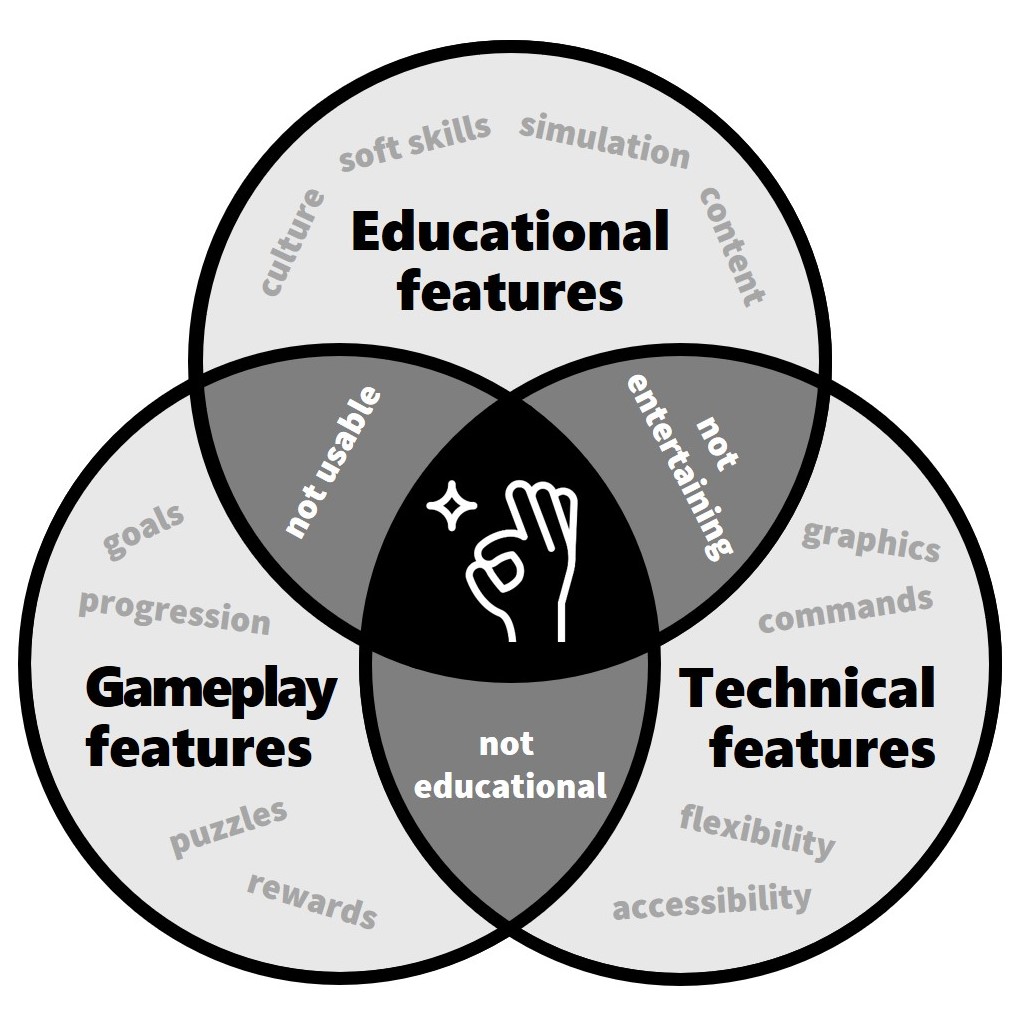 A Venn diagram of the perfect educational video game.
A Venn diagram of the perfect educational video game.
Satisfying all these requirements and demands is certainly a very difficult undertaking when searching for good games. It’s even more difficult for the game developers to create them and certainly it doesn’t help the fact that the industry of game-based learning doesn’t produce much wealth compared to regular video games.
Almost as hard is deciding how to correctly integrate video games into school lessons. Different types of games have different sets of features that have to be considered in respect to their application for educational purposes11. As a teacher, is important to choose games whose educational content is relevant, understandable by the students and that reflects their level of preparation, not to mention the fact that it has to be suitably contextualized in the lesson and matched with the curricular objectives. A post-lesson survey could be particularly useful to ascertain whether the experience has actually increased the students’ knowledge of the topic and their motivation to learn.
Society & sociality
Ok, I think I’ve talked enough about video games for education.
Now, since this is a personal blog, I want to talk about something else I experienced firsthand that correlates with video games at school, but not for their educational aspect. I hope it helps you understand how this set of benefits applies in practice to regular video games, too.
As a premise, in this context for society I don’t mean every human being globally, but just the local group of people inside a school and the social interaction with classmates and teachers in a class. This, though, doesn’t exclude that what I say can be applied also outside of the school environment.
In my years as a student, I’ve noticed the manifestation of a common behavior among my classmates and friends.
Every school year, there’s at least one short period, but often even more, where my classmates and I find a video game to play together with our smartphones*I understand that playing video games at school (regular ones) sounds like a very childish activity to do, but keep reading because I think it’s a wrong way of seeing them.. Usually, when one of us finds and shares it, in a few days many of us install the same game and during our free time (like the 15-minute break we have) we play in online co-op (multiplayer) mode together.
To cite some examples, that game can be Call of Duty Mobile, Among Us, Clash Royale or any other prominent online game of the moment. Indeed, these three games were the most popular ones played during my last three years of upper secondary school, 2019 (first), 2020 (second) and 2021 (third) respectively. The selection of which (free) game to play often depended on which game was the most in vogue in that period all over the world, but sometimes we would rediscover old games and play them again (for example, recently we played Rento, a 2016 online multiplayer monopoly board game).
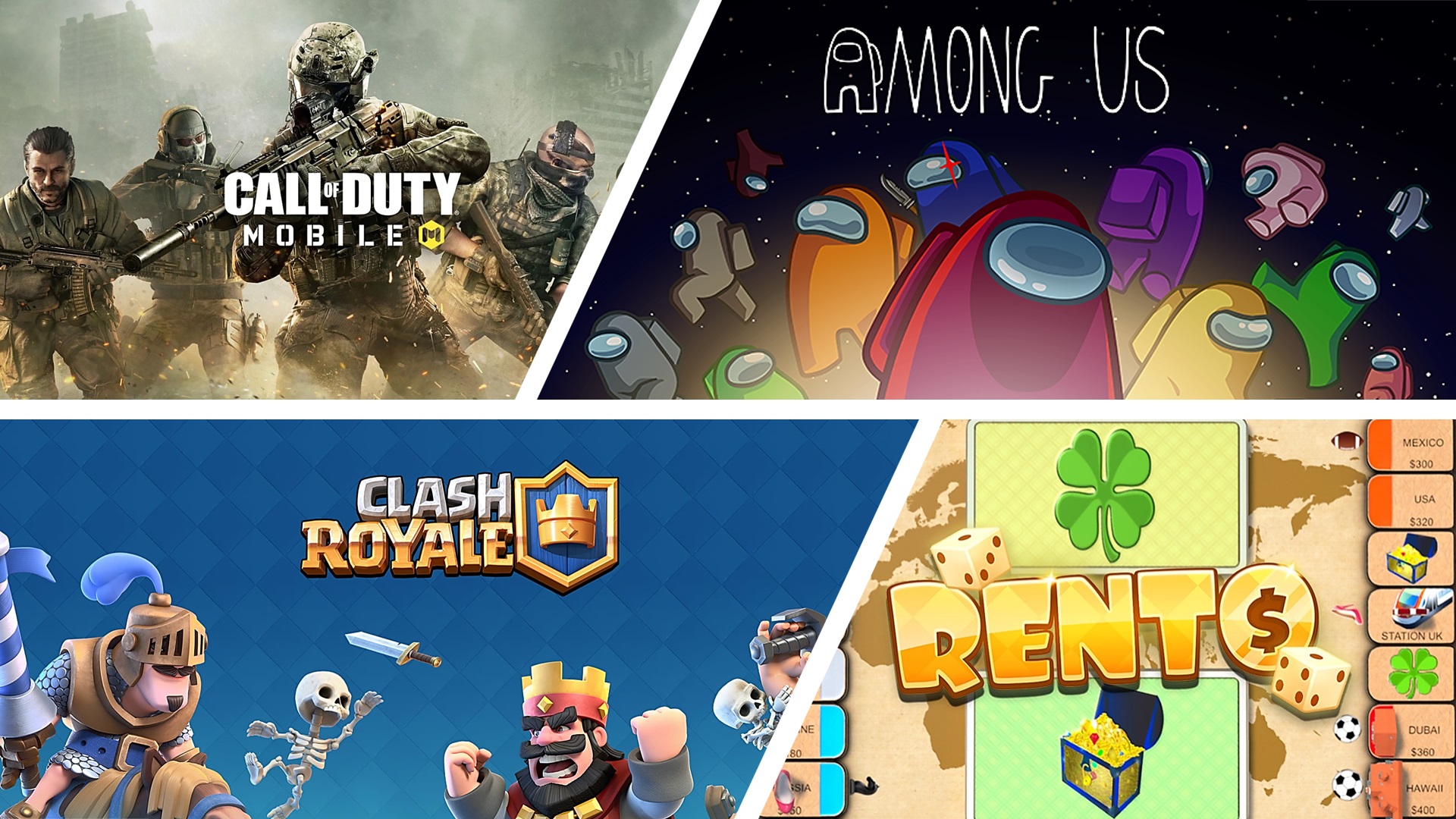 Some popular games we played together.
Some popular games we played together.
Those games are not even remotely educational in terms of cultural or scientific formation, but playing them with friends is a very fun activity, and I think that it’s something more important than it seems.
When we play together, we entertain our minds, take a break from the real world for a moment, socialize, spontaneously strengthen social and friendship bonds and simply have fun.
“Gaming for both children and adults alike serves as a common interest and point of conversation which can create bonds and enhance social skills. Multi-player and online games allow for constant communication between players which results in the development of both meaningful and casual relationships.12”
“Face-to-face relationships and those formed within online gaming communities both provide what we call social capital, which is an all-encompassing term for the social resources that make a friendship a friendship. […] Online, game-rooted friendships are as real as any offline friendships, and they shouldn’t be discredited just because they’re mediated through technology.13”
That’s why I think that using video games at school can be helpful for our minds and for the individuals of a social group to be more connected with each other. It’s something that school tries to do, too, but for us students there’s often too little time to really stay together, to have fun and smile instead of just studying and working hard. Don’t get me wrong, I don’t want to portray the school as a place of sadness and suffering. I just want to say that in addition to the moment in which the lesson is given, it’s also important to have a moment in which to talk, discuss and have fun with others and from this perspective video games can help us to do so.
There are many articles and researches that demonstrate the power of video games in reinforcing relationships among young people. I encourage you to read some of them:
- Psychology Today (Andrew Fishman) - Video games are social spaces: how video games help people connect (very good analysis of social relations and conversations when using video games)
- Pew Research - Video Games Are Key Elements in Friendships for Many Boys (scientific-statistical proofs)
- BBC The Life Project - How online gaming has become a social lifeline (boom of alternative socialization through video games during the COVID-19 pandemic)
It is true that games and technology in general can become addictive to students and prevent them from interacting with the outside world. All can be dangerous if abused and taken to the extreme.
If used correctly, though, multiplayer games (unlike social media, for example) can be helpful for having fun together without isolating from the real world and for that reason, I think they have an important role in the school environment. In moments of pause, video games should not be banned or stigmatized as a violent or isolating tool because they actually promote conversations and confrontations among people while the latter are entertained and their minds are turned away from study stress for a little bit.
Conclusions
Curiously, before writing this article, I was planning just to make a little list of games and write down some of my thoughts. Eventually, it turned out to be probably the longest post on my blog. Not only for the word count but also for the time taken (16 December – 28 December). The reason for that probably lies in the fact that I’m discovering that I’m really interested in education, and mixing this interest with video games, another great passion of mine, is a particularly effective combination! “Video games at school” turned out to be a far more interesting topic to discuss than I initially thought.
Anyway, as demonstrated, video games can be helpful in many, many ways, not just for entertainment needs. As well summed up in a paper, they “engage and challenge players, present complex representations and experiences, foster collaborative learning, and promote deep learning”14. In the classroom, they can enhance the school lessons on a wide range of topics, from STEM to history, from nature to storytelling, from art to relationships. They have the potential to change the landscape of education as we know it, so it’s a shame not to insert them into the students’ formation.
That potential, unfortunately, is yet to be fully unlocked, but I don’t think it’s impossible to see them used in schools around the world to teach younger generations.
I also hope this post will serve as a catalyst, encouraging schools and teachers to harness this tool and stimulate other people to slowly make these ideas a reality. Especially by embracing the educational value of video games, we can finally engage students in immersive learning experiences and inspire a passion for knowledge that can extend even beyond the classroom.
*Edit: this post will be updated with new video games and other content as I discover more things. The first update includes the addition of Beyond Blue, Valiant Hearts: The Great War, Bad News and new links. The second update adds Earth Primer, Cypher, the section “The perfect educational video game” and corrects some grammar errors. The third update adds the Little Mouse’s Encyclopedia game and my short film on The Divine Comedy made in Minecraft. The fourth update (2024) adds some minor other games and improves the writing and content of many sections of the post.
Enjoy the reading!*
Footnotes
-
Studiosity - Surprisingly Educational Games: Kerbal Space Program ↩
-
PC Gamer - Kerbal Space Program blasts into physics classroom as an end-of-year project ↩
-
Polygon - Valve details Teach with Portals, Steam for Schools educational initiatives ↩
-
Triseum Blog - Video Games Teach Us More than Just their Content ↩
-
Triseum Blog - Triseum Gives AP and College Calculus Students Direct Access to Variant: Limits™ ↩
-
It’s the ministry of the Italian government for the national education system. Wikipedia (en-us) ↩
-
Are There Differences in Video Gaming and Use of Social Media among Boys and Girls? ↩
-
British Journal of Educational Technology - Editorial: Play and learn: potentials of game-based learning ↩
-
‘Computer games can get your brain working’: student experience and perceptions of digital games in the classroom or alternative link to Google Scholar ↩
Other posts:
-
2025 end-of-the-year post
Annual recap of 2025 and what’s next.
-
My problem with GenAI
My principles and concerns regarding generative AI.
-
How I make my Anki decks
A set of tips & tricks and other useful info I learned while creating my Anki decks (and my university workflow).

